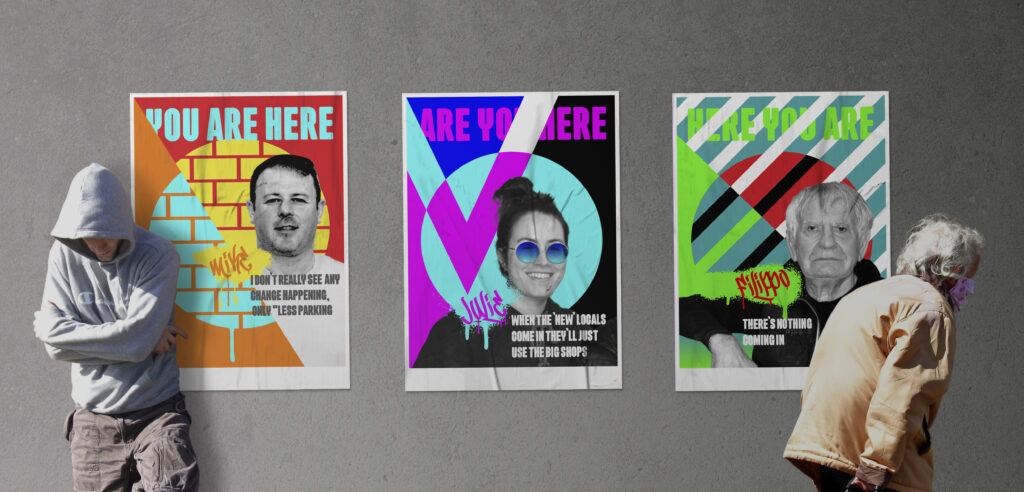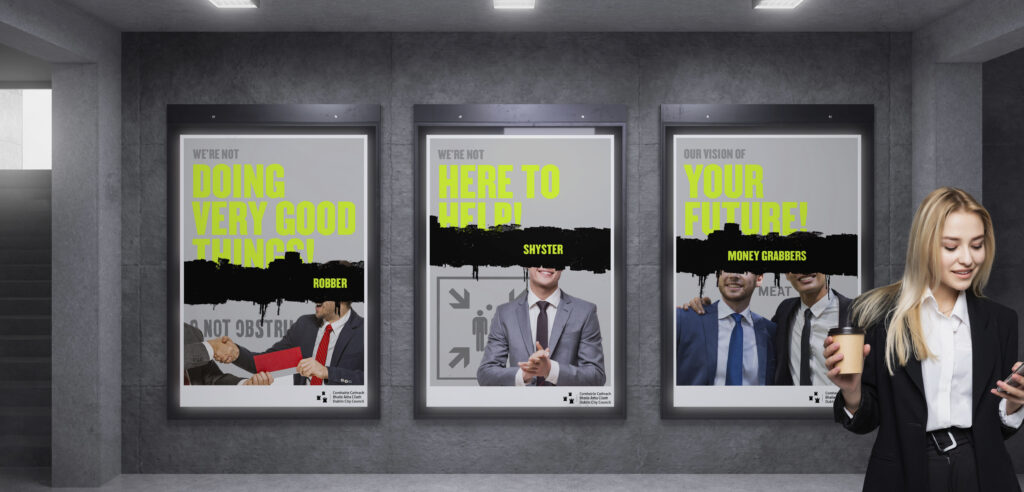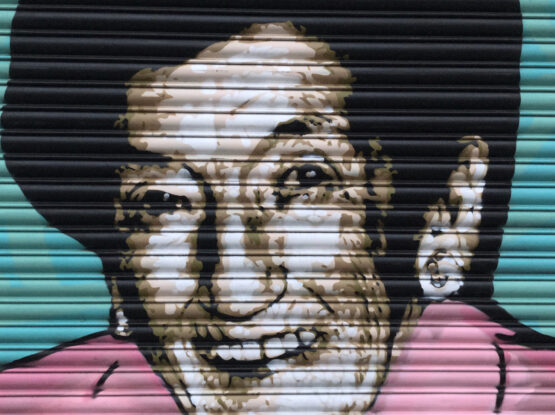REFLECTIONS ON LECTURES/SOURCE MATERIAL:
Noticing the ignored, experiential drawing, capture, writing, recording, play and photography.
In John Berger's 'Way's of seeing' he constantly comes back to the concept that if you are looking at a print, through the medium of television where an image may be cropped, or embellished through the influence of incidental music, you are not really present in the moment of actually looking at or understanding the visual stimulus put before you. Are you really removed from the subject or your understanding of it? Is this a Jungian projection, where both John and the viewer (you) have made their own minds up?
I am interested in his idea of not being present. The unnoticed is not present in the forefront of your mind. That's why it is unnoticed. Or has it been hidden from view on purpose?
The Goya painting of the soldier awaiting imminent execution made me think of Robert Capa's 'Falling Soldier' picture taken during the Spanish civil war. At the time (1936) the photograph was acclaimed as one of the greatest ever taken, but since the 1970s, there have been doubts about its authenticity due to the discovery of staged photographs taken at the same time and place (Wikipedia). So this raises questions both about whether Capa was really present in the moment and of our own beliefs and reactions as the viewer when the truth being told could be a lie? Was he where he said he was when it was taken? Who is the soldier in the photograph? Where is the location? All unknown…
"They say the camera never lies. It lies every day."
Cesar Romero
—
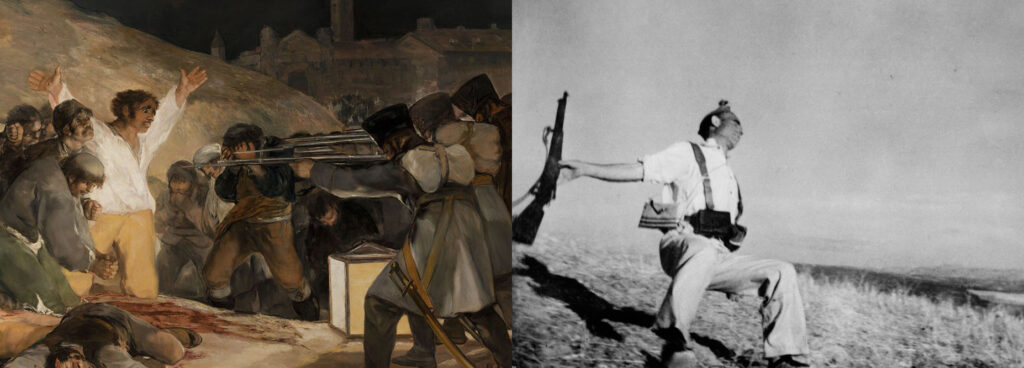
This idea of not being 'present' also made me think of the work by Adam Broomberg and Oliver Chanarin (Watch: Genius of Photography/Right Time, Right Place) where they show and discuss the 'Chicago' project (broombergchanarin.com/hometest#/chicago-1-1-1). In the BBC programme, they illustrate with a series of photographs, the lengths Palestinian suicide bombers will go to to disguise their bombs. Your first impression of the images is of a series of inane objects: a watermelon, hamster cage or fire hydrant but your perception is dramatically changed when you understand their dark and hidden meaning. Broomberg and Chanarin argue that you don't have to see the result of these devices to understand their sinister nature. These visually ignored lies have real consequences and although we are not present in the moment we gain an understanding of their significance.
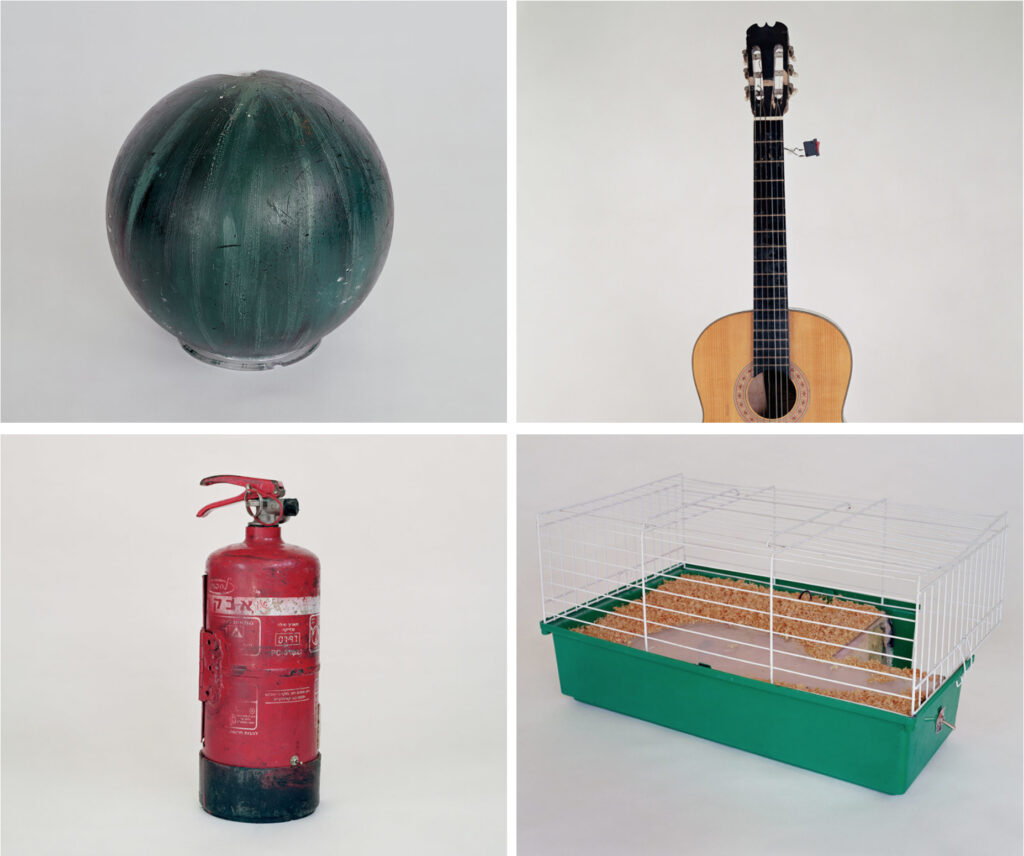
So do you need to be present in order to gain insight? The situationists held the idea that the distortions of consumerism and the media was a kind of controlled apathy of the individual and sought to experience life through a series of 'derives' or drifts in order to stay present and in the moment. While I understand this and agree in part with this instinctive reaction to modern life, their mantra being "make daily life a creative, continuously original, delicious, ecstatic experience", their Psychogeographical approach feels like a contradiction in what they initially set out to achieve. Were they really present in the moment walking through Paris with distorted maps, or both present and lost in a sea of attractions and repulsions? They also claimed the "time for art is over" but were they not in themselves making art with statements, cut ups, publications and graffiti? A 'we are here' statement perhaps, 'we are present', 'we must be heard' if 'we are' to really change the world.
What is interesting is that they saw their derives as walks through 'historical landscapes whose structure and appearances were shaped by temporal events that were buried but never completely erased' (Suzanna Edwards). This aspect speaks to me as in every city there are remnants of a forgotten or unnoticed past waiting for those who are interested to uncover. But do you need to be there to notice them? Is this not just a case of revealing the history rather than going for a meandering derive? You may discover the significant and unnoticed on a derive but what do you actually know or learn from this without digging under the surface? 'Who was here'?
"Life can never be too disorientating."
Guy Debord
—
I was taken by Emily Richardson's and Ian Sinclair's 'Memento Mori' project where they capture what are now lost landscapes and when Regular Practice talk about Charles Booth's 'poverty maps' it also struck a chord with me how the passing of time constantly changes perspectives both socially and physically, which Tom briefly picks up on himself. In this sense is not every piece of art, photography or recorded music not just a passing moment in time, or is it an affirmation of our own existence? 'You are here'.
Booth and Debord's maps also made me think of wartime Ordinance Survey cartography where draughtsmen were instructed to make whole swathes of sensitive government buildings disappear (Watch 40.00mins youtube.com/watch?v=w5_kWzUahQU), deleting the present. And at the same time in Russia, Alexander Rodchenco was forced by Stalin's regime to remove 'aparatchiks' or dissenters from history with his airbrush. One day a politician may have been in favour, the next he could be facing the firing squad as an enemy of the people (rbth.com/history/329317-stalin-propaganda-photos). Maybe this distortion of the media is what Guy Debord and his band of pranksters were referring to. That an individuals perspective can be altered without first hand experience. These and other dark times in history show us that what we ignore can also become non-existent and easily forgotten. 'You were here'. It is therefore important that we keep looking and seeing beyond the surface in all the ways the world reveals itself to us.
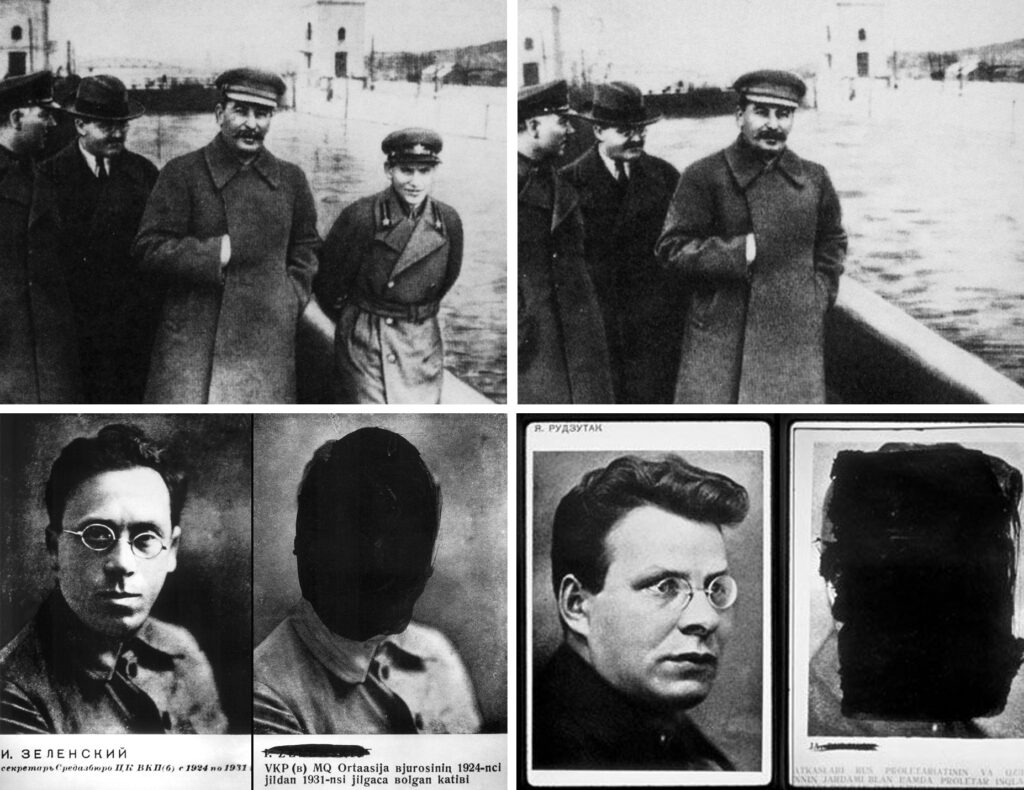
"When we are younger we see the surface. As we mature we look beyond it."
Peter Saville
—
TAKE OUTS
— Look, look again and then really 'look'.
— Nothing is what it at first seems.
— Use all available methods, processes and mediums available to you to record.
MIND MAP EXPLORING THE WAYS IN WHICH WE RECORD
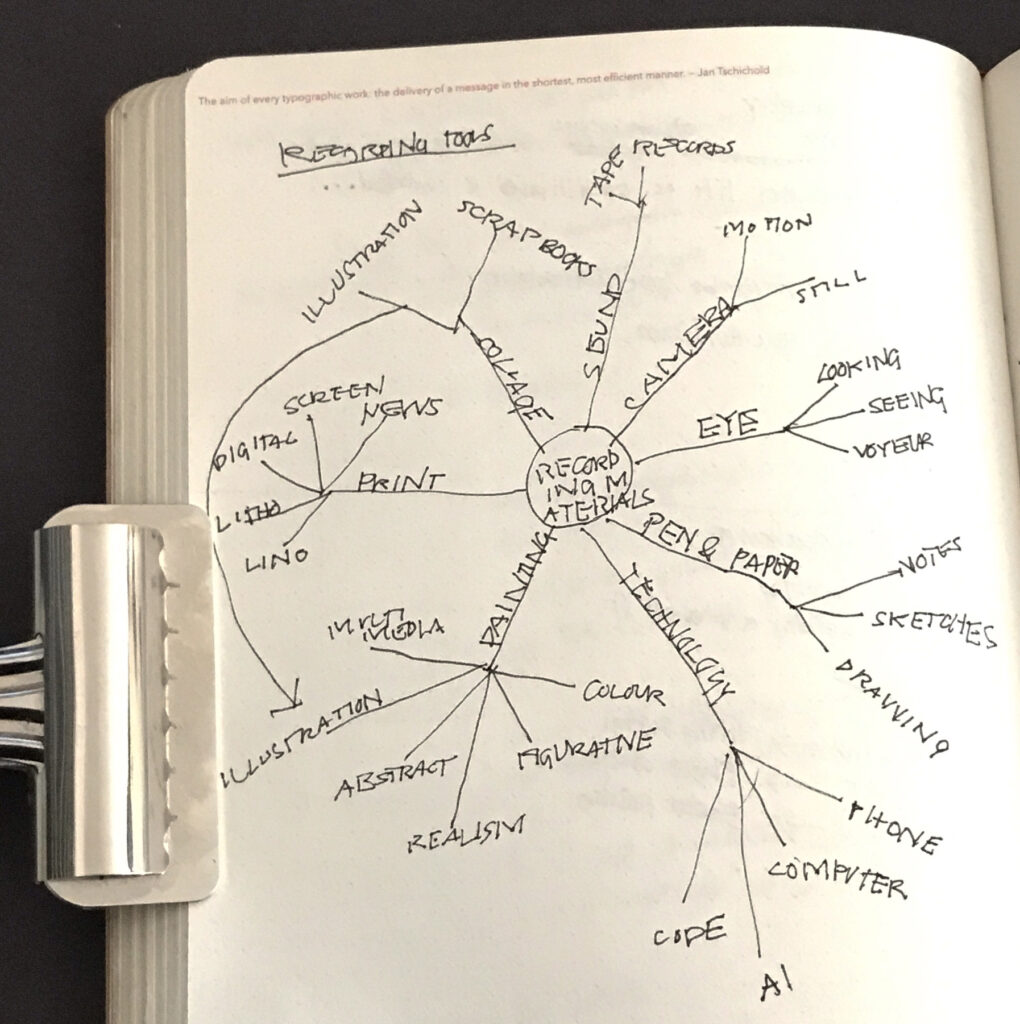
Workshop Challenge: Geographic Location
As I am partially disabled I have chosen not to find a Street a mile away but to focus on my local area and Meath Street in the Liberties Dublin.
MIND MAP EXPLORING MEATH STREET
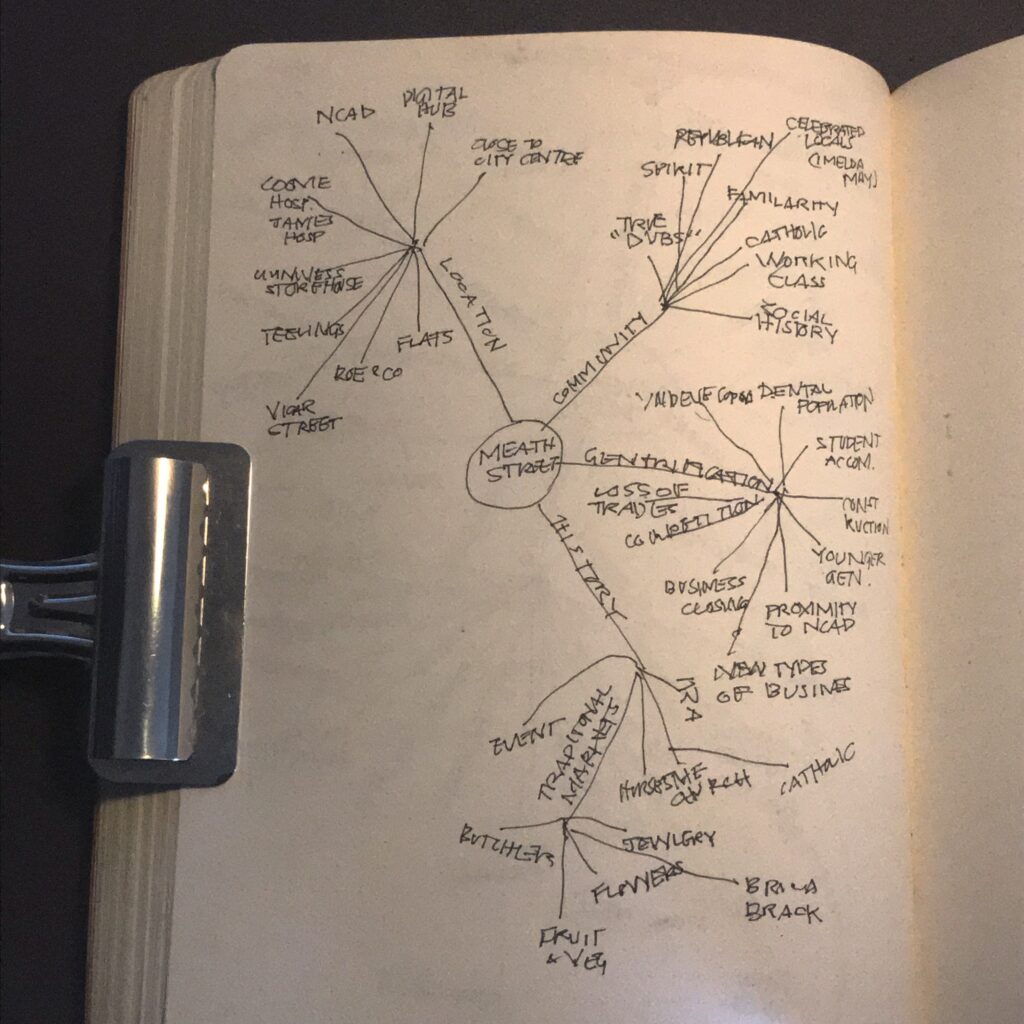
HERE'S A LITTLE FILM I CUT TOGETHER TO GIVE A FLAVOUR OF THE HISTORY, THE CHARACTERS AND THE STREET ITSELF:
1: Greenhorn Films, in association with 925 Productions and Failsafe Films: The Liberties.
2: RTE: Eamonn Mac Thomais - Dublin, A personal view - The Liberties Part 1.
3: Liberties Cultural Association: Christopher Moriarity talks about the charitable ethos of The Quaker Community.
4: Areaman.tv : Trolly Dollies, Brenda and Chipperman directed by Shane Hogan and Tom Burke.
5: The People We Meet: The people we meet part 17.
6: The Liberties Dublin: Excerpts from a promotional film by the city council depicting the regeneration of the area which is slowly but surely breaking up a long held sense of community and forcing independent retailers out of the area.
PHOTO JOURNAL PART 1:
A walk down Meath Street looking for the unnoticed
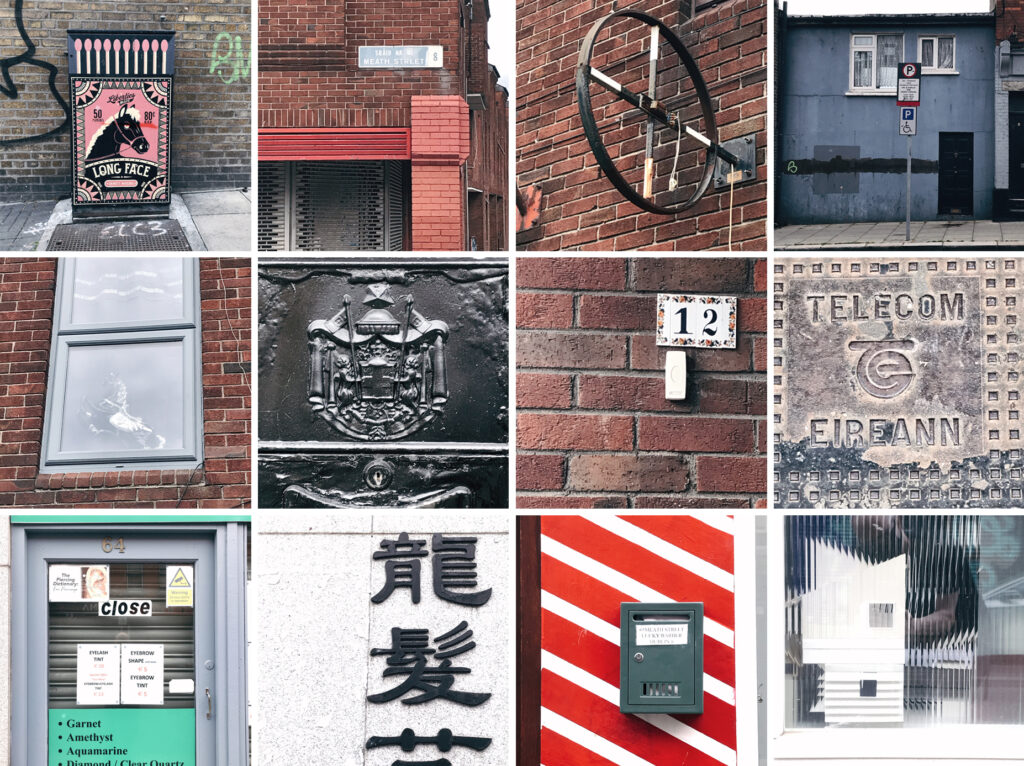
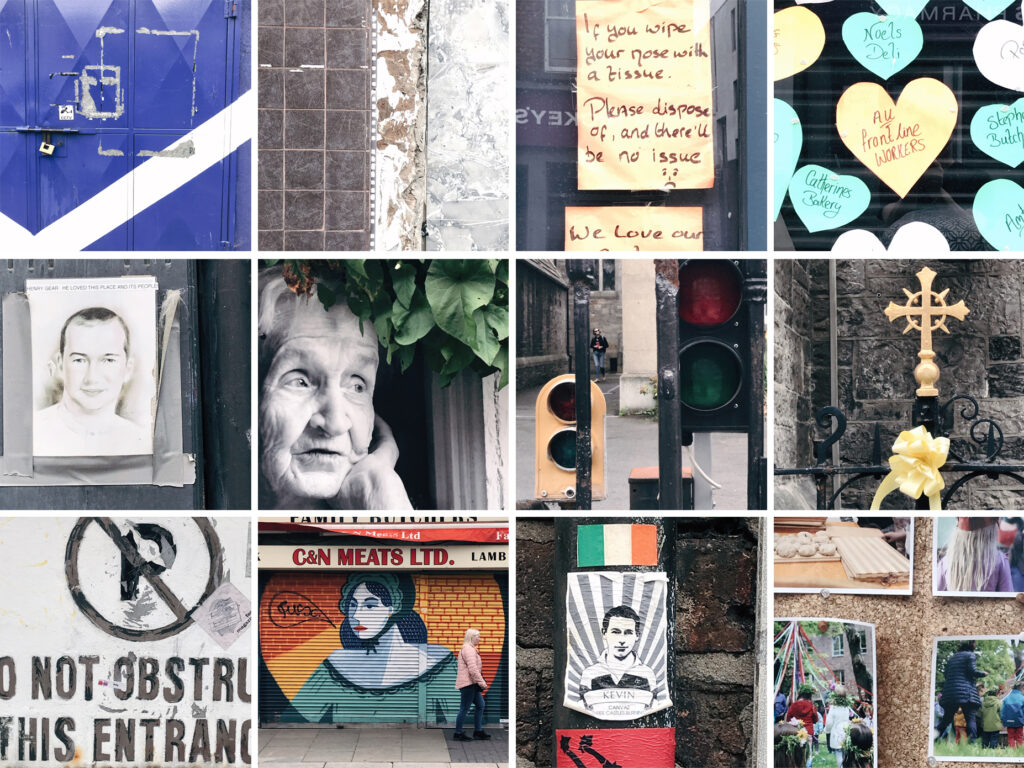
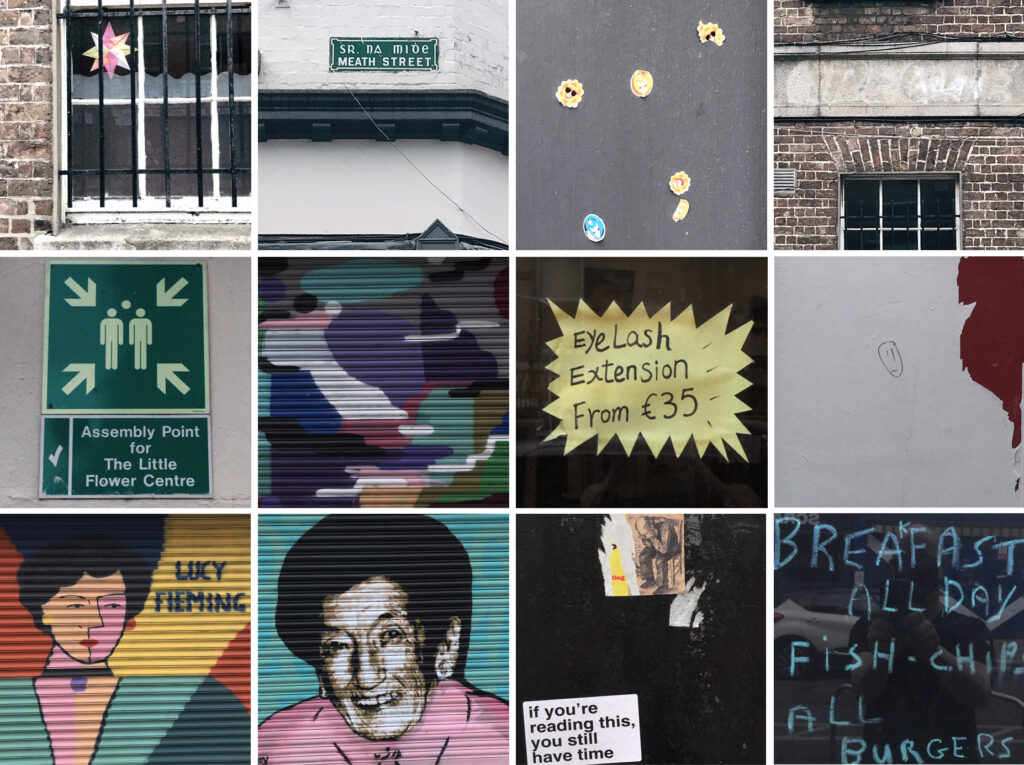
TAKE OUTS
— The houses with their china horses and floral numbers tell us that this is a little bit of heaven. It's home.
— The handmade, misspelt signs reflect both the working class culture, and the warmth and humour of the people in the area.
— They also tell of the independent retailer surviving against all the odds.
— Local heroes and ordinary people are celebrated on shutters and lamp posts and never forgotten.
— Run down in appearance but not in spirit.
— With oncoming plans for refurbishment the characters could get forced out and the community lost.
A LITTLE BIT ABOUT MEATH STREET & THE LIBERTIES
1: Meath Street was laid out in the late 17th century, in the domains of the Earl of Meath. In 1680, a stonemason by the name of Wheeler was commissioned to draw up plans for a new thoroughfare with the intention to create a spacious and fashionable residential enclave in the semi-rural western suburbs of Dublin with the the Wide Streets Commission carrying out later work in the 18th century.
In its earlier years, Meath Street would have been lined with gabled buildings, after the fashion of the time with some accounts pointing to buildings having balconies, showing the eclectic mix of styles and foreign influences in the area (mainly Huguenots).
Almost from the start the street developed into a thoroughfare of merchant shops with living accommodation above, and a concentration of the Quaker community in The Liberties in the early 18th century resulted in businesses such as bookshops, publishing houses and educational establishments. You can still see the remains of the arched entrance to the Quaker meeting house beside Fusco’s (Chip Shop) at 26-27 Meath Street.
2: The area grew into an industrial suburb of Dublin, with an extensive tradition of brewing, distilling, tanning, weaving and trade in agricultural produce.
The distillery buildings of John Power were founded in the Liberties in 1791 and by the 1880s, was considered to be the most technologically advanced in the world, even including its own bottling plant. The site is now the National College of Art & Design.
1: By the mid-18th century, many of the thriving industries in the area began to decline dramatically as competition from England and elsewhere began to take its toll. The area became increasingly disadvantaged, with poverty and overcrowding becoming rife by the later 18th century and into the 19th.
Gradually over the 20th century the street lost more and more of its older building stock, with new buildings being usually bland and functional and often single or story in size. Handsome details such as timber shopfronts and joinery were lost.
3: While the fortunes of the area declined in the 20th century, Thomas Street and Meath Street remained the quintessential heart of Auld Dublin, renowned in song and story. The area has produced its fair share of storytellers, master musicians, street characters and thespians.
Today, it retains its distinctive character and curious detachment from the life of the wider city. 4: There is no doubt that The Liberties holds a special affection for many Dubliners. Locals will tell you that it’s because they are ‘the real Dubs’; that here is where the story of city began over 1,000 years ago; and If you know where to look, you’ll find connections to some of the pivotal moments in Ireland’s history.
1: Dublin Civic Trust’s 2008 Study of the Past, A Vision for the Future: Meath Street & Francis Street.
2: en.wikipedia.org/wiki/The_Liberties,_Dublin
3: dublin.ie/live/stories/dublin-uncovered-the-liberties
4: libertiesdublin.ie/visit-the-liberties/history-of-the-liberties
A LITTLE BIT ABOUT THE FUTURE OF MEATH STREET
5: Final planning approval for a proposed revamp for Meath Street, led by Haslem & Co Architects for Dublin City Council, is now expected to be made in summer 2021.
The current plans provide for:
Widened footpaths providing more generous pedestrian space, outdoor terraces, street markets and activities.
Level walkways across all junctions, new uncontrolled crossings, accessible parking bays, public seating.
Introduction of street trees and landscaping.
Revisions to parking and loading arrangements and increased cycle parking provisIon.
New public lighting for a brighter street.
Some views on how the street might look:
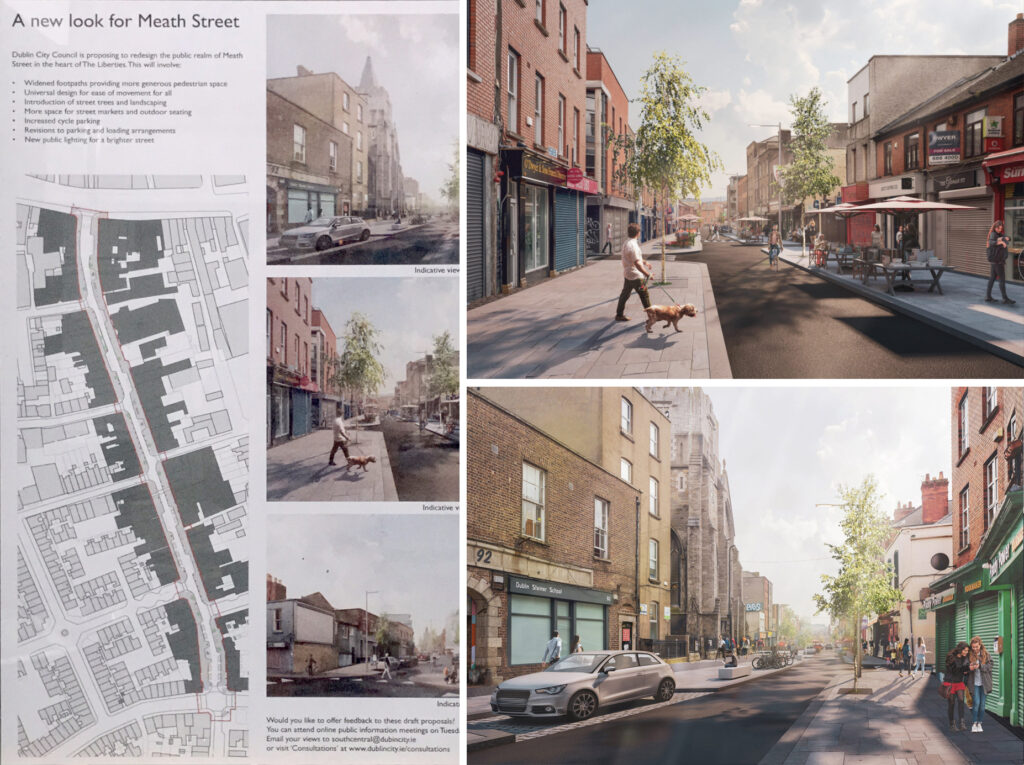
5: libertiesdublin.ie
TAKE OUTS
— With an upcoming plan of rejuvenation I fear that the characters and real community here will eventually get forced out.
— The danger is it will become just another Dublin shopping street and the history of traders and trading will eventually be lost.
— The thing that makes this insignificant little street what it is are the people and the community they have created.
— Independent retailers will get overtaken by new independents and chains, and the sense of community will shrink, not grow.
— While I see the benefit of upgrading I don't really believe this is where the planning stops as new businesses start to move in.
— We have already personally experienced buy out mentality happen when new student accommodation was built.
Workshop Challenge: My personal interpretation of Meath Street
— Meath Street is a hive of activity life, community and colour.
— I want to explore the idea that gentrification is trying to delete the community that currently exists here, in the present.
— I feel that they could be the ignored because of who they are and their status in life as members of the working class.
— Taking inspiration from the 'ordinary heroes' painted on shutters, I want to look an idea around apparatchiks and heroes.
— My next part of the photography exercise will be to ask some locals for portraits for the project and to ask them what they actually think about these plans.
— I also want to incorporate some of the textures, patterns and type found on my first walk.
PHOTO JOURNAL PART 2: MEET THE LOCALS
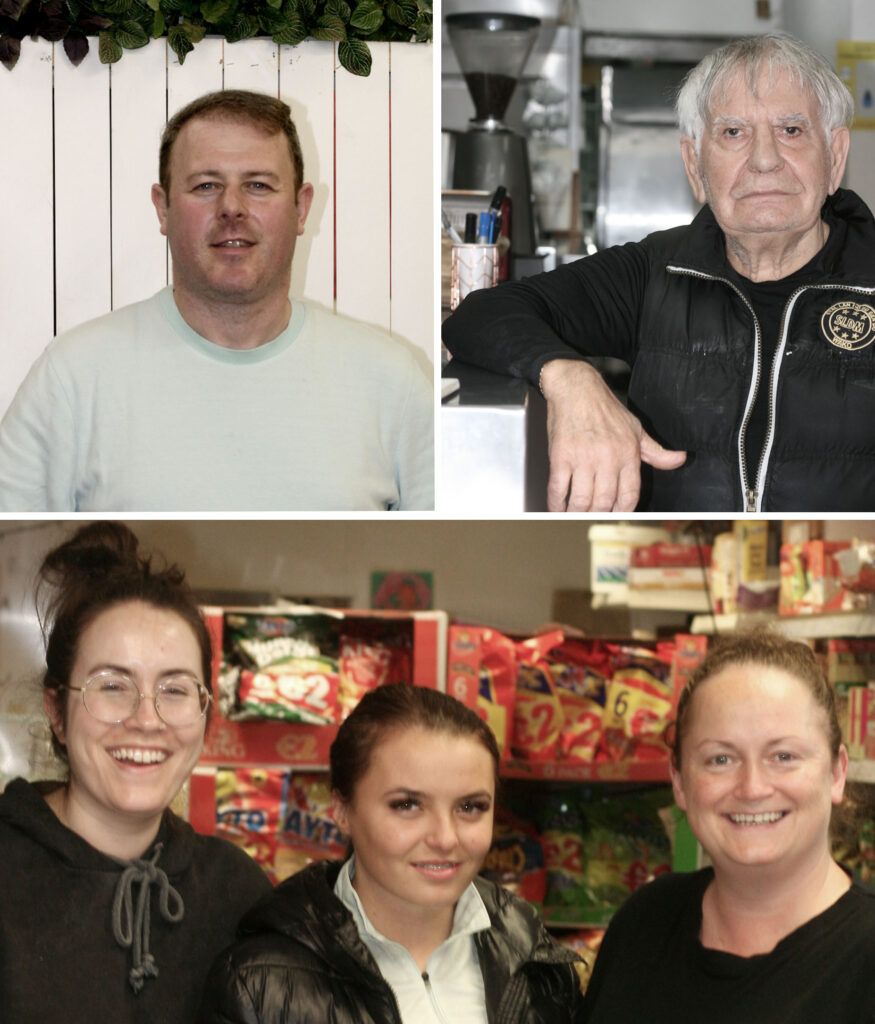
ABOVE LEFT: Michael Norton (Here 26 Years), ABOVE RIGHT: Fillipo Fusco (Here 58 Years), and BELOW: The Girls in Noel's (Noel Fleming started work in the Liberties when he was 13 in 1963). L to R: Julie, Ciara and Susan.
INTERVIEWS
When I walked into Michael Norton's shop (formally Jack Roche's) I was met by Demitri and a young woman (Ciara O'Rourke) enaged mid conversation about the proposed planning. So it is top of peoples minds. Ciara told me the community was already dying and was opposed to the rejuvenation because of what she has seen happen in the area. She said that as soon as the works done it will be filled with "Telecoms, Insurance Companies and more Bookies" (we already have 3). Michael Norton on the other hand doesn't really see any change happening only "less parking". His grandfather started here in 1946 and he has been in the area for 26 years himself. I asked if he see's himself getting pushed out and his reply was somewhat hesitant "I hope not". Michael said he brings "charm and friendliness" to the area with no mention of the amazing array of fruit and veg on display. His local heroes from the area are Brenda Fricker (Actress) and Andy Lee (Boxer). I mentioned Imelda May and he said don't put her in "I don't like her".
"There's plenty of villan's in the area but there's still a strong sense of community. You walk up the street and 10 people will say hello."
Michael Norton/Grocer.
—
For a lot of the businesses in the area they are just trying to get past Coronavirus first before being faced with the next set of problems. For Fillipo Fusco this is at the top of his mind - "There's nothing coming in". When he started his business in the 60's the markets were open from 11am til late in the evening 7 days a week with 58 shops open from the Coombe to Thomas Street. As soon as the supermarkets came in on Thomas Street, people started going elsewhere to shop, even the locals. When he started there were only 2 supermarkets in Dublin but you had to travel to get to them so Meath Street was thriving. He partly blames the current decline on the stallholders themselves as they stopped selling every day and the quality of the goods being brought in was and is poor. With a few of the local businesses, long before the council got involved; he started an Association and acted as treasurer to help businesses, clean up the street, fix the lighting and "keep the robbers out". In younger years he was a champion kickboxer so he also held sway with keeping people in line. The businesses paid a fee of 10 Punt a week for the service. They brought in Christmas Tree's and Santa, with sweets for the kids. They also paid for a bus to come from Tallaght to Thomas Street so people had transport links to the markets from the suburbs. He's been to the council talks surrounding the new proposals but it's all self interest by the developers (makes an Italian gesture. Bruno Munari will have to help me out with this one but I think it means 'it's a bit of a farce', waste of time) . At this point his son Fino interjects:
"It's fucking shit. Its' gone to pot. The place needs to be done up."
Fino Fusco/Chipperman
—
Before I leave I ask if he feel's he'll be pushed out. It's exactly 56 years since the shop was first opened and Fino's (real name Philip) birthday. 'Naah - I already been here 56 years". With pictures of family and Imelda May on the walls, we already know who his local heroes are, except most of the family pictures are just a younger Fillipo throwing kickboxing shapes and looking like Al Pacino.
Strangely when I go into Noel's and tell Julie what I'm doing (Fleming/Noel's daughter) she says "its funny we were just talkin' bout that". Also here since the 60's (Noel's not Julie), Julie feels they haven't long before they are gone. ""It's a double-edged sword… It's hard to know until after Covid and it does need doing, but when the 'New' locals come in they'll just use the big shops". I can see it happening after what's being (been) done on Thomas Street and down there in the Coombe. When the Hyatt hotel came in they told everyone that they would employ from the local area and I only know 3 people that work there". I ask if she feels that this is because of the area being largely working class "yeah, there is that side too. Like, the girls who work here will leave because eventually they won't be able to afford the area". Her heroes are "the people that have stuck it out like her Dad, Little Flowers Penny Dinners, Fusco's and Jack… "Jack Roche is gone now too". "The last thing we need is more hipster barbers and coffee shops, everyone's selling up and they're building more student rentals than social housing".
"If we're here in 10 years it'll be a miracle. Once it's done, all the things people came here for will be gone".
Julie Fleming/Local shop girl.
—
TAKE OUTS
— There's still a community and there's hope that it doesn't leave the street.
— Mixed feelings about the development work across the board. The younger generation agree it needs to be done but are fearful of the future.
— Amongst the older generation the decline started when the big supermarkets moved in on Thomas Street.
— Generally there's a feeling of inevitability about it, that the council have made up their mind regardless and they are not really listening to local people.
— Hard to name the villains as there are plenty of them but 'real' local heroes.
ROUGH CONCEPT SKETCHES
Exploring the idea of making a hero's and villian's set of posters. Heroes being the locals who feel powerless to stop 'progress' from happening. Have this idea that came from the shutters of immortalising them in some way to express that they 'are here' and won't be forgotten. I also like the idea of incorporating 'you are here' into the hero posters referencing map location, sense of place. It's a bit like someone scratching 'I was here' on a desktop. The villian's of the piece are the developers who push ahead regardless of the show they put on to present a softly, softly approach.
THE SKETCHES
— Real people, 'Real Dubs' for the hero's, using photography either illustrated or altered from the photo journals. Charm, friendliness, warmth.
— Textures, type, paint splashes, graffiti, and colour from the photo journals.
— Hero's and permanence idea inspired by the painted shutters. 'Ordinary folks' who did extra-ordinary things. 'You Are Here'.
— Bold, graphic and vibrant colour palette for hero's like the shutters. Monochrome for the villian's with sickly colours palette.
— Villian's more slickly produced. No real character or warmth. Like a bank or government prospectus. Annual Report photography. Cheesy.
— Villian's caught in the act: Brown envelopes, slaps on the back, suitcases of money, dodgy dealings.
— Hero's just being themselves. Honest, nothing hidden.
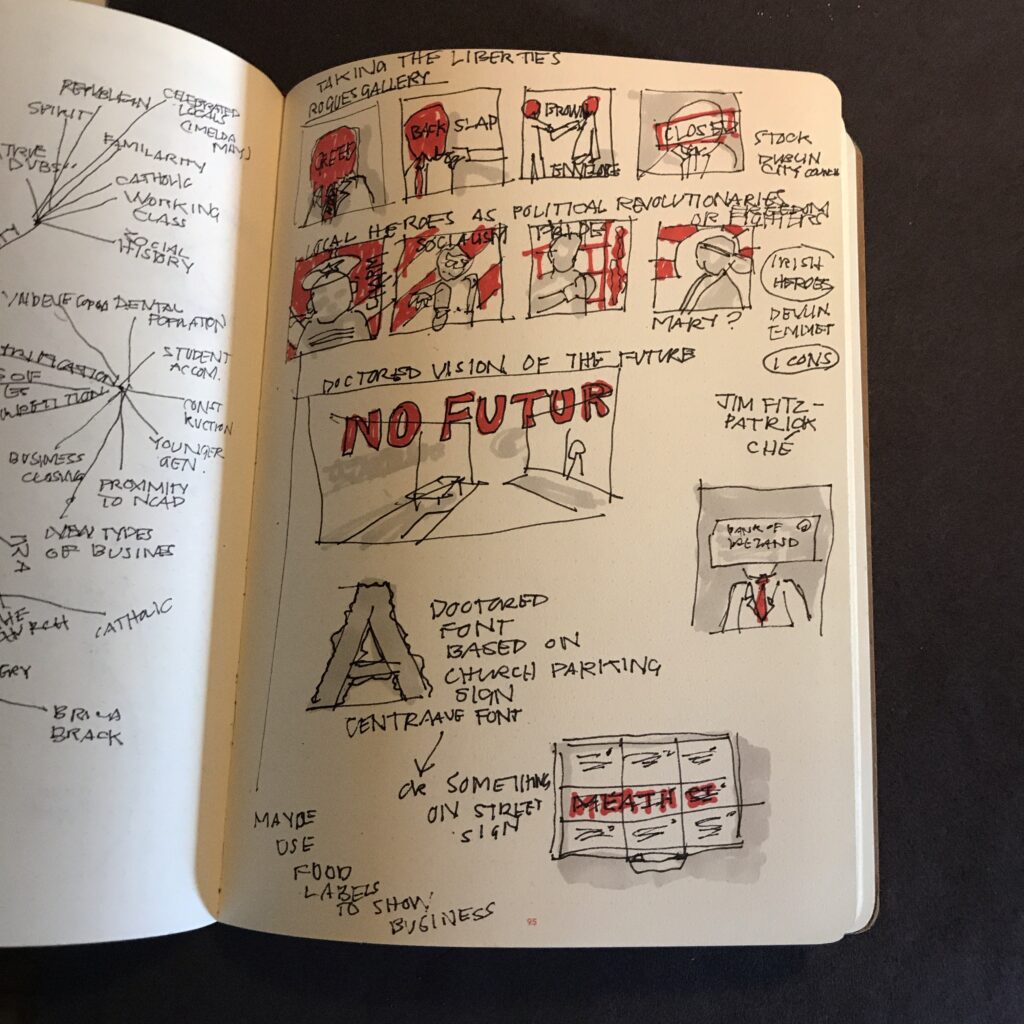
CONCEPT DEVELOPMENT / MOODBOARD'S:
— Focusing in on the details, colours and textures from the photo journals.
— Looking at creative ways to use or build up the elements.
— Stock business image search for villian's.
HERO's
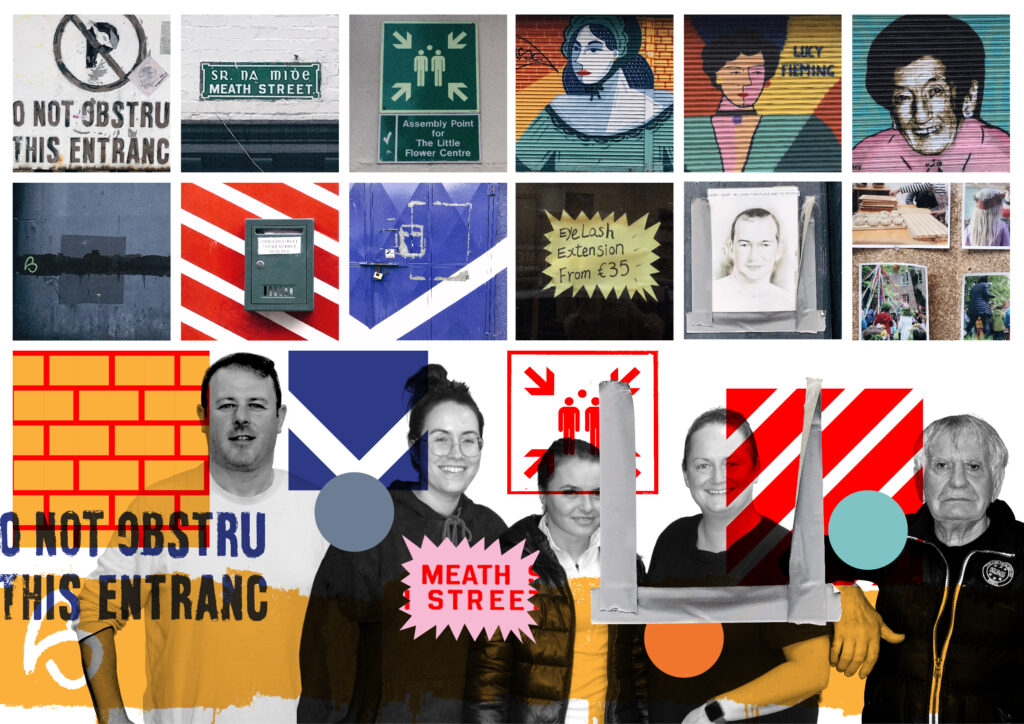
— I think the found type elements could be used. I would like to have the time to make a font but need to focus on the 'poster' sets.
— Colours for the hero's can come from the shutters and the bricks, barber stripes and Liberties market stripes could be used graphically.
— I'm thinking of a kind of do it yourself approach here so it retains it's charm and warmth.
— I've taken the colour out of the images to unify the style and maybe make them more like the image top right.
VILLIAN's
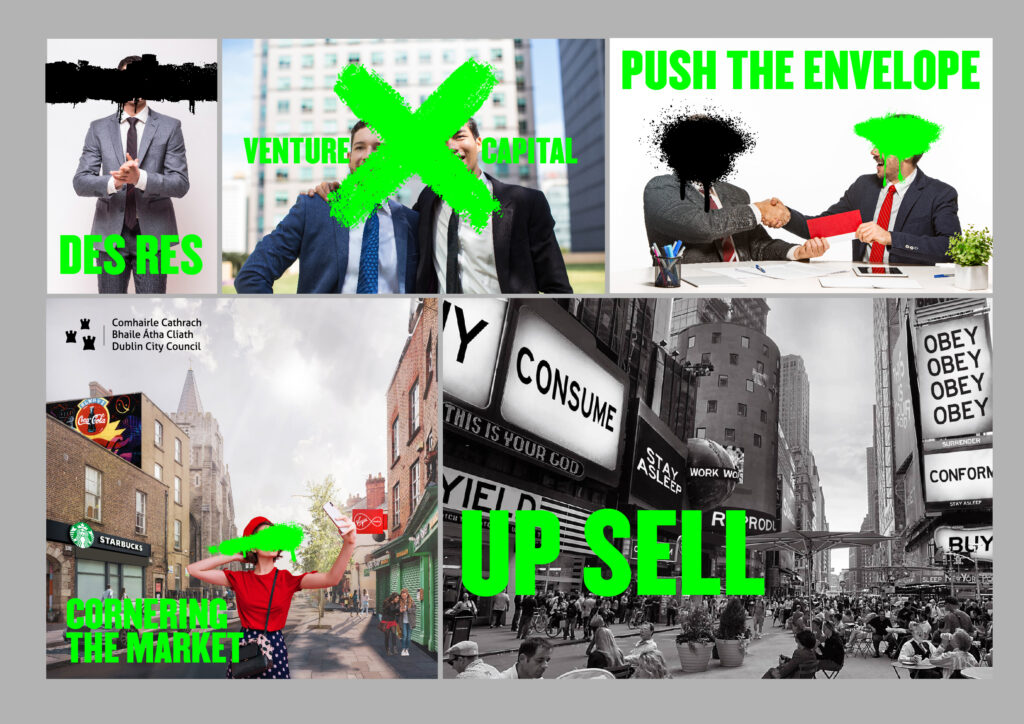
— More of a slick approach taken with the photography but I also like the idea that they have been defaced in some way like the apparatchiks.
— Thinking of using marketing speak as slogan's with some kind of sinister twist added.
— The idea is starting to take shape and makes me think of the film 'They Live'. Dystopian visions of a future, decided for you.
— I was also playing with their vision of what the street will look like adding a Starbucks, Phone Shop and brand driven graffiti.
Workshop Challenge: Concept Development
— Starting to disseminate elements from the moodboard's and use them in a graphic way.
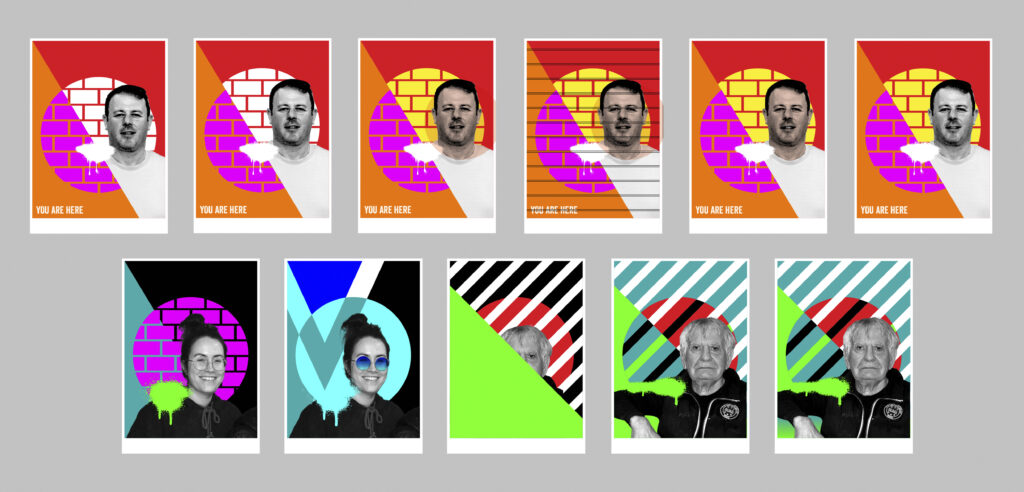
ABOVE: Step by step sketches looking at introducing background abstracts, graffiti and shutters with integrated portrait photography.
Workshop Challenge: Final Execution
— Callling the project 'Taking the Liberties/Making the Liberties'.
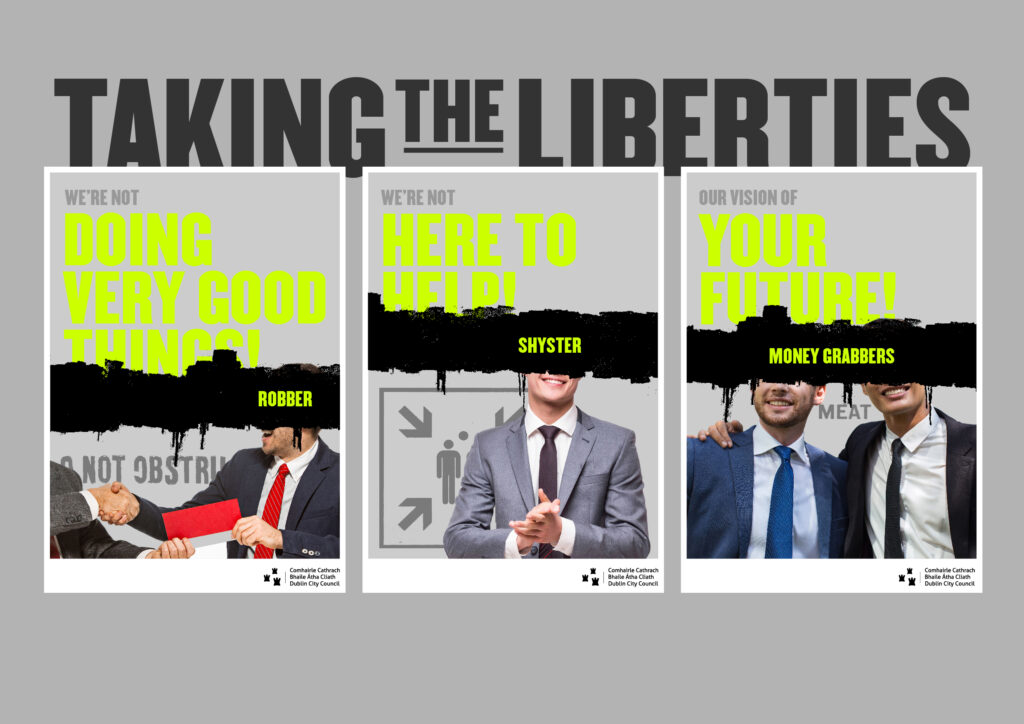
— Idea is based around a kind of anti corporate campaign that tells the real intention, I.E: The culture of greed.
— Using the language of large corporations but turning it on it's head with with a double negative.
— Using slick stock photography for extra 'cheese' turning the corrupt businessmen into apparatchiks.
— Using the graphics of the streets to invoke that something is not quite right.
— Monochrome and sickly colour palette.
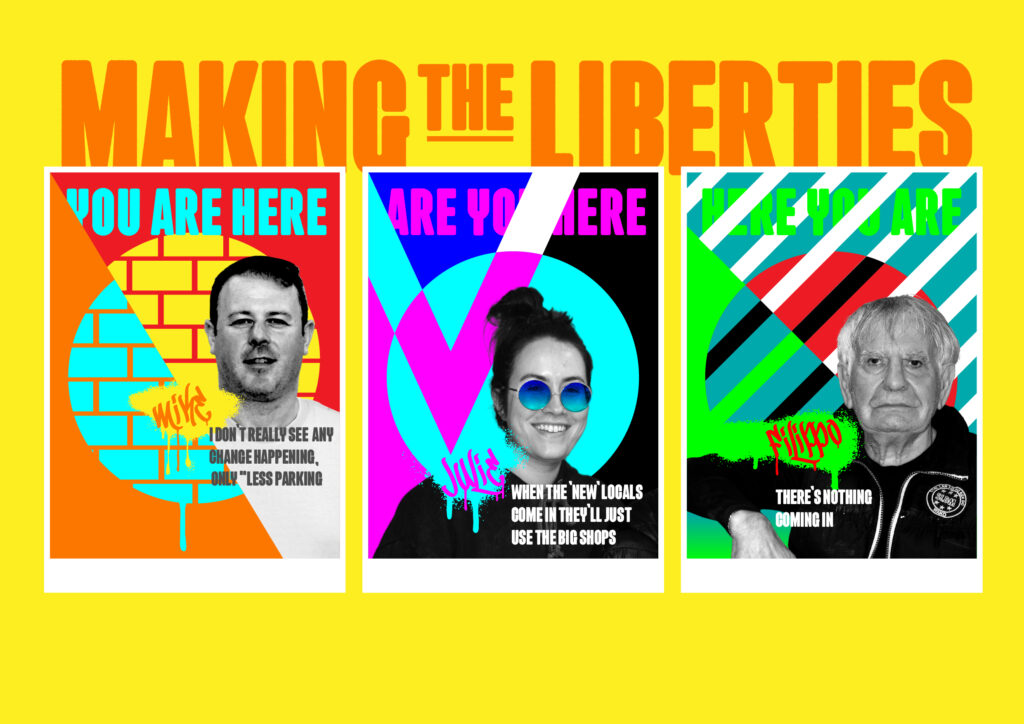
— The local hero's immortalised as shutter icons.
— Abstracts and circles taken from the photo journals and shutters.
— Bright, vibrant and full of charm and friendliness.
— Twist on language relating to the quotes, "You are here, are you here, here you are".
— Graffiti plays a part here too but it is to welcome each character.
